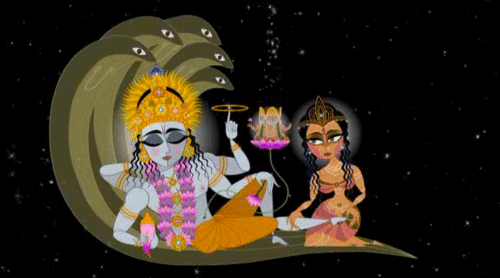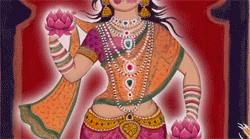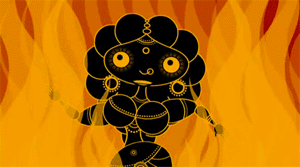 |
| In the film’s opening sequence, Sita rubs Rama’s leg. |
So before I start, let’s address the elephant in the room. This film is about The Ramayana, an important text in Hindu mythology, and primarily focuses on Sita, an avatar of the goddess Lakshmi, who is married to Rama, an avatar of Vishnu. But the film was written and directed by a white animator, Nina Paley. There is some effort to represent the story and Indian culture faithfully (and the only non-Indian members of the cast play white characters), but the sense of humour and deliberate contrasting between ancient tragedy and modern comedy leaves an undeniably western perspective on this legend. So, yes, this film counts as cultural appropriation. That is not exactly what I’m going to be talking about today, since I am frankly unqualified to do so. I have read objections to the film by Indians, and they naturally are far more knowledgable about the Ramayana and Hinduism in general. I’m just a white atheist who went to Catholic school, and my only previous knowledge of the Ramayana is from a very shortened version I read in a fairy tale collection as a child.
But even considering the cultural appropriation problem, I still like this film. There is no media which is not problematic in some fashion. You can still like problematic things provided you recognize and understand what the problematic elements of the film are. Sita Sings the Blues is beautifully animated, quite funny, entertaining, and introduced me to the music of Annette Hanshaw. But the concerns that Indians have brought up about the film’s depiction of the Ramayana are valid. Therefore I am going to try to approach this film in the most balanced way I can – I want to focus on the things that are great about it, but also criticize the parts that are problematic. If you are unfamiliar with the film, or have not seen it in a while, it has been released under a Creative Commons licence and is available to watch for free on the film’s official website, YouTube, and Hulu.

 |
| “Big, round, firm, juicy…LOTUSES!” |
The Good:
- I love that this is a successful indie film written, directed, edited and produced by a single woman, Nina Paley, and the film is about a woman of colour. You can really tell this was a labour of love for her, and it’s an incredible achievement that one animator was able to do a feature length film on her own. The film is also explicitly meant to be feminist – in a long summary of the film that she released to the press, she described Sita Sings the Blues as “a tale of truth, justice, and a woman’s cry for equal treatment.” I hope to see more films helmed by women, and not just independent ones. I know that women of colour have an even harder time getting recognized as filmmakers, and I would like to see this same story retold from someone who grew up in Hindu culture, as opposed to a westerner. WOC filmmakers often do not get given a chance to succeed, as they are never given funding nor marketing, and naturally blamed for their films’ financial failure. Quite a vicious cycle. I would love to see more ways for feminist film lovers to discover films made by women and women of colour.
- One of my favourite things in the world is animation, so this film’s widely varying animation styles (and narrative styles that change with the visuals) was such eye candy for me. If I’m counting correctly, there are 6 styles of animation used in this film. The film starts with a stylized Sita rubbing Rama’s leg (depicted in the animated gif at the top), led by stylized and symbolic depictions of the gods. It then rotates into other animation styles. Nina Paley’s autobiographical portions are done in a scribbly, loose style. The 3 Indians who narrate the story are represented as shadow puppets. The Ramayana characters’ dialogue is shown through two different forms of Indian-style artwork – one with lots of detail and bright colours, one with wide, expressive eyes and simple use of colour. The bulk of the film is devoted to Annette Hanshaw jazz songs as “performed” by Sita to complement the narrative. The sequences are presented in a modern vector graphic style, with lots of circles used in the character designs, and is even more stylized in presentation than the introductory sequence. Finally, one scene depicts an Indian woman drawn in white stencil dancing in flames and singing to Rama (it’s kind of hard to describe). Because the visual and narrative styles rotate so quickly (no portion is over 5 minutes) the story keeps you interested and you never stay in one style long enough to get bored.
- I love the Annette Hanshaw sequences, but I have to say, my favourite parts of the film are when three English-speaking Indians from various parts of the country, Aseem Chhabra, Bhavana Nagulapally, and Manish Acharya, narrate the story of The Ramayana and are represented as shadow puppets. I love listening to the very subtle differences in their accents, and how the oral tradition of the story has subtle variations depending on cultural location. I’m just sorry they weren’t identified by name (I had to use the Wiki to credit them) so I could tell them apart beyond “Two males, one female.” Because their discussions are unscripted and they are reciting the story from memory, they make lighthearted jokes about the story, modernize some of the language (one describes Sita telling her kidnapper Ravana that his “ass is grass.”), argue mildly about details and names, and point out some of the plot holes. I laughed out loud when the three agreed that Sita left a trail of jewelry for Rama to follow, then one wondered how much jewelry Sita was wearing to be able to drop jewels for that long a distance. In response, another one says, “Don’t challenge these stories!” I also found it interesting that as they told the story, they questioned some of its details. Ravana is supposedly unquestionably the villain, yet had a past of being learned and a noble warrior. They wondered why he would be so out of character as to kidnap another man’s wife. One also marvelled that the supposed villain did not do the cliche thing and force himself upon Sita. I think questioning and analysis of one’s own culture is a good thing, so I really ate up the shadow puppets’ discourse on The Ramayana.
- Probably the most popular sequences of the film are the stylized vector graphics of an impossibly curvy (she’s all boobs and hips and almost no waist) Sita “singing” jazz and blues songs performed by 1920s singer Annette Hanshaw. Hanshaw has this incredible ability to filter deep emotion through her voice, and having Sita perform these songs gives her a necessary amount of emotional depth. All we know of Sita via the narration is that she is absolutely devoted to her husband, no matter what. The Hanshaw songs thus have Sita expressing joy, adoration, heartbreak, hope, and acceptance, while still maintaining that necessary devotion to Rama. This is important since, no matter how you approach the story, Sita has a very tough time and is treated unfairly – we know that Ravana never touched her and Sita has only ever been with Rama, but she is still punished for even the possibility that another man touched her. The woman whose agency was taken from her should be given a way to express herself, so the blues sequences are a nice compromise.
- Finally, the gif above depicts another one of the better points of the film, which is its sense of humour. In this scene, Ravana’s sister is trying to tempt him to kidnap Sita by describing her beauty. She says, “Her skin is fair like the lotus blossom. Her eyes are like lotus pools. Her hands are like, um, lotuses. Her breasts are like big, round, firm, juicy…LOTUSES!” Sita’s story is unquestionably a tragedy, so the little sprinklings of humour here and there keep the movie from being emotionally draining. I like the use of deliberate anachronisms to emphasize the differences between the ancient Indian setting, and the modern culture of today. Annette Hanshaw’s songs reference technologies that naturally wouldn’t have existed in ancient times, so Paley instead has Sita humorously hold a banana next to her ear when Annette sings about using a phone. And as I mentioned before, the little jokes that the shadow puppet narrators make (and their disagreements on plot details and names) help to make the narrative as lighthearted as possible. I admit I really dislike films that depress me, so this narrative decision appealed to me.
 |
| Sita sings “Mean To Me” while going through her trial by fire |
The Problematic:
- Okay, now for the flaws. The autobiographical bits retelling the end of Nina Paley’s marriage are terrible. They drag the story to a screeching halt, the loose, drab and scribbly animation style contrasts far too much with the sumptuous and colourful styles used in the other animation sequences, and the story seems far too biased towards Nina’s perspective. I naturally don’t know the details of what really happened, but I have trouble believing that Nina’s former husband Dave is as selfish, heartless, sexless and aloof as she depicts him as being. There had to have been a reason he suddenly lost interest in her beyond their being separated by his job for some months. And I feel so uncomfortable discussing a woman’s personal life, and yet she put this stuff right in her movie, so I can’t help but talk about it! I really think that the autobiographical portions should not have been in the film. It might have been cathartic for her, but it’s awkward for everyone else.
- Another big problem with the autobiographical portions is that I think it’s going too far for Ms. Paley to directly identify herself and the end of her marriage with Sita and her marital problems. Sita and Rama are more-or-less Hindu gods, so for a mortal white woman to compare herself with them has to come off as kind of blasphemous and egotistical. I’m glad she found comfort and inspiration in reading The Ramayana, but I would have left that revelation as perhaps a footnote or just a single scene. The autobiographical bits are interspersed throughout the film to contrast/compare directly to the chapters of Sita’s story, so you’re quite obviously supposed to identify the two women together. There are lots of western films where a character is meant to be a Jesus analogue or is Messianic in some way, but it is almost always a symbolic comparison, not an overt one. There’s no attempt at symbolism here, and I have to wonder if it would still be acceptable even if it was purely symbolic.
- Ms. Paley is also unfortunately channelling her grief and anger over the end of her marriage through her depiction of Rama. This is supposed to be the most virtuous and wise man living, and yet the film depicts him as cruel, cold, weak-willed and stubborn. I, too, would question his supposed perfection after he continued to doubt Sita after she already passed his trial by fire (depicted in the gif above). But I think his character has to have been exaggerated somewhat in this film. Some of the people writing objections have argued that in The Ramayana, Rama was extremely broken-hearted and reluctant to banish Sita, but she loved him so much she persuaded him to send her away so that he could be an effective ruler for his people. That’s some extraordinarily self-sacrificing behaviour on Sita’s part, but it seems much more plausible considering the first half of the story is emphasizing how much they absolutely love each other.
- This negative depiction of Rama goes as far as to basically make him the real villain of the story instead of Ravana. He is even shown kicking, pushing and walking over Sita while she is heavily pregnant. WHOA. It’s really going way too far to depict a man of being a domestic abuser if there isn’t any evidence for it. Again, this is an avatar of a god, and even though he has made a mistake in doubting Sita and sending her away (putting his own reputation amongst his people above the love of his wife), this exaggeration of his character is offensive. When Sita bears Rama’s twin sons and they are raised to praise him, they even sing a sarcastic song about how great and wonderful Rama is and that his word should never be questioned. I get the feminist attempt to question why the man’s judgement is always accepted above the rights of the woman, but the questioning should be directed at their own culture, not someone else’s. Just like we don’t like it when other cultures judge us by their standards, we don’t have the right to judge them by ours either.
- The film’s biggest problem is that it is judging ancient Hindu mythology and custom by modern western feminist standards. If a modern western story came out where a wife is kidnapped, her kidnapper demands to marry her but does not rape her, she is rescued, her husband fears that she has been “tainted,” she proves she hasn’t, and yet is still suspected by others, and is ultimately banished while pregnant with her husband’s sons, and the husband is still depicted as the hero of the story, I would understand the virulent criticism. But because this is the story of the Ramayana, it’s not fair for a white feminist to start complaining about it, and then create a film which reflects mostly her views without making it clear she’s taking liberties with the story. Yes, it’s obvious that Sita never sang jazz songs, but it’s not so obvious that Rama wasn’t actually as cold and cruel to her as he is depicted in this film.
- This unfortunately reeks of the cliche where white feminists go to women of colour and start telling them that they are oppressed by their culture and condescendingly try to “free” them from it. Women of colour can speak for themselves and make up their own minds. That’s what intersectionality is all about – we do not tell people of other cultures (and gender identities, and sexualities, etc etc) how they’re supposed to act and think. The first time I saw this film a few years ago, I was just as angry at Rama as Ms. Paley wants me to be, because I was completely ignorant of the story. It wasn’t until I started researching for this review that I found out that, wait a sec, she’s not depicting him accurately or fairly. When you have the influence to present another religion’s story to an audience that is likely going to be unfamiliar with it, the responsible thing to do is to either depict it accurately, or make it clear that it is an exaggeration. Sita Sings the Blues’ messages have unfortunately been diluted because of this strongly problematic element.
So while my feelings on Sita Sings the Blues are conflicted, I still think that it is a well made film despite its flaws. I encourage people to make up their own minds about it. If nothing else, the film gets us to consider differences in cultures and religions, and white women’s feminism vs the feminism/womanism of women of colour.
I don’t think Nina Paley is intentionally racist, she’s just fallen victim to one of the big problems of western culture where the white person forgets that their perspective and opinion is not the only valid one. The vast majority of people won’t think about this sort of thing unless they immerse themselves into social justice culture, and even then it’s quite difficult to adjust your way of looking at the world. As one poignant Tumblr post said (and I’m paraphrasing), in social justice spaces we try to explore deep intersectional concepts like the erasure of trans* people of colour. In the “real” world we struggle to explain to people that ‘feminism’ is not a bad word.
I also do not think that the film should be banned or censored like some right-wing groups have demanded, but I do think Paley should have made it more clear that she was taking some really strong liberties with the story. I have struggled for weeks trying to figure out how I was going to approach this film, so I hope I have been as fair as possible in my review. If nothing else, I have gained yet another new perspective and understanding of this film via my research on it, and that’s the best I can hope for.
P.S. I am trying a new experiment where I decorate the review with custom-made animated gifs of the film/show I’m reviewing, rather than just grabbing stuff off of Google Images. Please let me know if you like this new format, or whether you’d prefer static screenshots instead.
Myrna Waldron is a feminist writer/blogger with a particular emphasis on all things nerdy. She lives in Toronto and has studied English and Film at York University. Myrna has a particular interest in the animation medium, having written extensively on American, Canadian and Japanese animation. She also has a passion for Sci-Fi & Fantasy literature, pop culture literature such as cartoons/comics, and the gaming subculture. She maintains a personal collection of blog posts, rants, essays and musings at The Soapboxing Geek, and tweets with reckless pottymouthed abandon at @SoapboxingGeek.
